Ocean Pollution Facts
Pollution in our oceans and waterways takes many forms, from litter and marine debris to agricultural runoff and pesticides. With All Hands Alliance, we can all take a leadership role and help turn the tide.
-
26 percent
Amount of atmospheric carbon dioxide the ocean absorbs
-
Just 12 percent
Of the oil in our oceans comes from oil spills—much more comes from road runoff
-
5.25 trillion
Pieces of plastic in the ocean
-
8 million tons
Yearly plastic accumulation in the ocean
-
705,000 tons
Of discarded fishing gear continue to “ghost fish” the world’s oceans
-
9 percent
200,000 identified species live in the oceans, but actual numbers may be millions
-
80 percent
Plastic from land-based sources




Studies indicate marine life ingests plastic, either as a function of filter-style feeding methods, or by mistaking plastic for its naturally occurring food. The result are fish, seabirds, and sea turtles who no longer feel hungry as their digestive tract fills with plastic, while being unable to derive nutrition from what they have eaten.
- An estimated 705,000 tons of discarded fishing nets continue to “ghost fish” the world’s oceans, catching and killing fish while also entangling marine mammals, sea turtles, and other marine life.
- Studies have shown that nearly 25 percent of fish sold at markets in California contained plastic in their digestive tract, mostly plastic microfibers.
- Agricultural runoff, untreated sewage, and discharge of nutrients and pesticides account for 80 percent of marine pollution.
- Studies show that about half of all sea turtles worldwide have eaten plastic, which can cause them to choke or sustain fatal internal injuries.
- Marine species including fish, sea turtles, mammals, and seabirds also are susceptible to engtanglement in plastic waste, including discarded or lost fishing nets, fishing line, and other marine debris.
- Of the 120 marine-mammal species that are classified as threatened, 54 percent have been observed ingesting plastic or being entangled in plastic debris.
- The ocean absorbs approximately 26 percent of the carbon dioxide added to the atmosphere by human activities each year. While this reduces the impact of this greenhouse gas on the climate, it’s damaging to the marine ecosystem. When carbon dioxide dissolves in seawater, it forms carbonic acid, a chemical reaction that leads to ocean acidification, and ocean acidity has increased by 30 percent since the Industrial Revolution began.
- Microplastics are tiny pieces of plastic, measuring less than 0.2 inches (5 millimeters), that are microbeads used in some cosmetics or the result of larger pieces of plastic breaking down physically into smaller pieces.
- Many plastic bottles are made out of polyethylene terephthalate (PET), which is a resin derived from fossil fuels—natural gas and petroleum.
- PET plastic bottles also have water as an ingredient, so every one-liter bottle uses about two liters of water.
- Every ton of PET plastic bottles produced generates about three tons of carbon dioxide.
- Ocean acidity caused by greenhouse gases emitted by human activities each year makes it hard for many small ocean organisms to generate their carbonate shells and structures, and has already begun to make it impossible for these organisms to live in some places.
- Plastic pieces are not only made of chemicals that are unhealthy for the natural environment and animals, they also absorb and accumulate toxins including pesticides (such as DDT), neurotoxins (such as PCBs), and carcinogens (such as PAHs).
- Persistent toxins do not degrade in the oceans, instead entering the bodies of marine organisms.
- Chemicals carried by plastics accumulate more and more as they move up the food chain, where filter feeders are eaten by larger fish and so on, resulting in top-line predator species such as bluefin tuna and swordfish having the greatest concentrations.
- Ocean acidification, along with warming surface waters, may reduce the ability of the ocean to absorb carbon dioxide, leaving more of this greenhouse gas in the atmosphere and worsening its impact on the climate.
- 500 different ocean locations around the world are now recorded as dead zones annually, encompassing nearly 95,000 square miles.
- Natural ocean currents also concentrate plastics near the center of gyres, resulting in such events as “The Great Pacific Garbage Patch.” Such consolidations are happening in every ocean, so removing the plastic that we encounter is the first meaningful step in a long journey.
- Other than plastics that have been incinerated—which causes a host of additional pollution problems—the entire volume of plastic humankind has created is still on earth.
- More than 800 marine species have been harmed by debris, which can cause injury, illness, or death.
